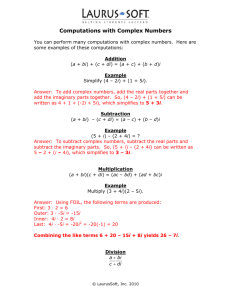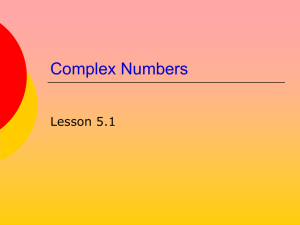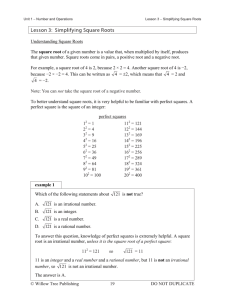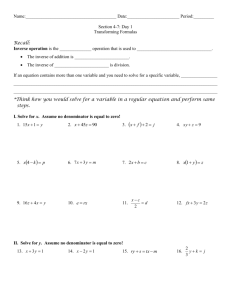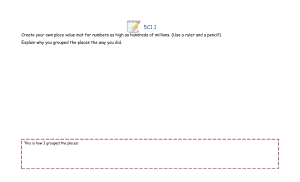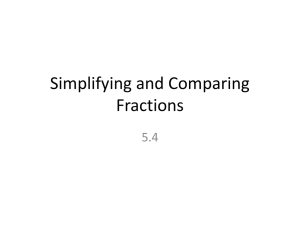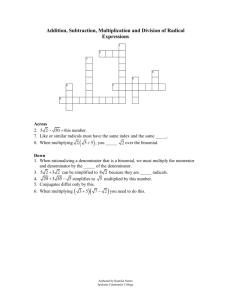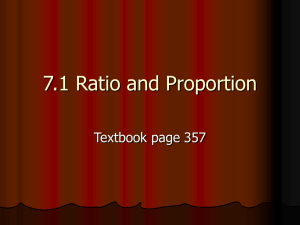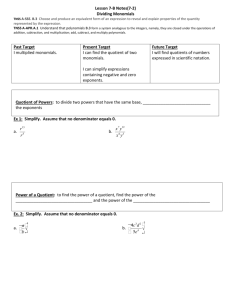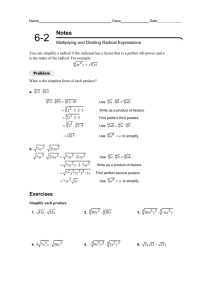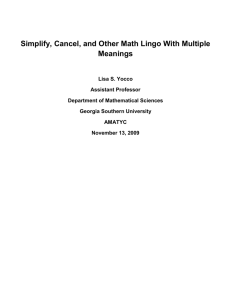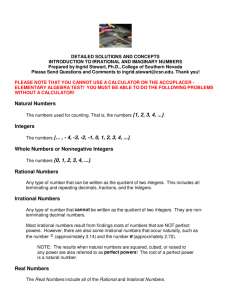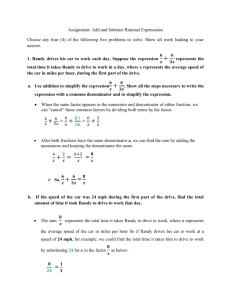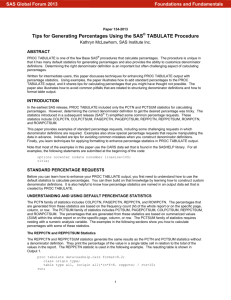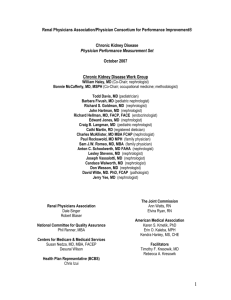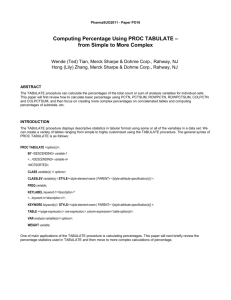Lesson 1-7 Complex Numbers
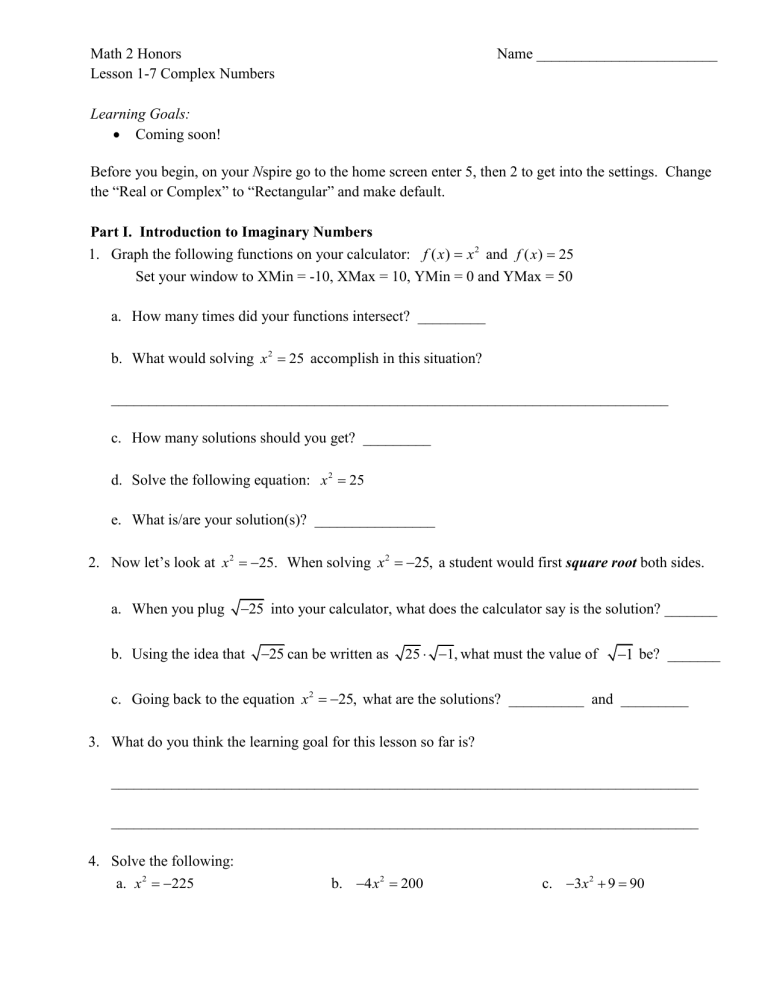
Math 2 Honors
Lesson 1-7 Complex Numbers
Name ________________________
Learning Goals:
Coming soon!
Before you begin, on your N spire go to the home screen enter 5, then 2 to get into the settings. Change the “Real or Complex” to “Rectangular” and make default.
Part I. Introduction to Imaginary Numbers
1.
Graph the following functions on your calculator: ( )
x
2 and ( )
25
Set your window to XMin = -10, XMax = 10, YMin = 0 and YMax = 50 a.
How many times did your functions intersect? _________ b.
What would solving x
2
25 accomplish in this situation?
__________________________________________________________________________ c.
How many solutions should you get? _________ d.
Solve the following equation: x
2
25 e.
What is/are your solution(s)? ________________
2.
Now let’s look at x
2
25.
When solving x
2
25, a student would first square root both sides. a.
When you plug
25 into your calculator, what does the calculator say is the solution? _______ b.
Using the idea that
25 can be written as 25
1, what must the value of
1 be? _______ c.
Going back to the equation x
2
25, what are the solutions? __________ and _________
3.
What do you think the learning goal for this lesson so far is?
______________________________________________________________________________
______________________________________________________________________________
4.
Solve the following: a.
x 2
225 b.
4 x 2
200 c.
3 x 2
90
5.
What do you think i
2
equals? __________ a.
Since i
2
can be written as the product of i i , what is another way to express i
2
using what you learned in number 2 part b ? ________ b.
Simplify your product from part a completely. ____________ c.
i
2
= ________
6.
What is i 3
? _______
Show your work to explain your answer.
7.
What is i
4
?_______
Show your work to explain your answer.
Fill in the table to find a pattern for i raised to different exponents. i
i 5 i
2 i
3 i 4 i i i
6
7
8
i 9 i
10 i
11 i 12
8.
For what values of n is i n
a real number? _____________
9.
What must be true about n if i n
= 1? __________
What expression would give all possible values of n that would make i n
=1? ___________
10.
What must be true about n if i n
= -1? _________
What expression would give all possible values of n that would make i n = -1? ___________
11.
For what values of n is i n
an imaginary number? _______________
12.
What must be true about n if i n
=
1 ? _______________
What expression would give all possible values of n that would make i n
=
1 ? ___________
13.
What must be true about n if i n
=
1 ? _______________
What expression would give all possible values of n that would make i n =
1 ? ___________
14.
Solve the following: a. i
40 b. i
66
c. i
33 d. i
115 e. i
11 i
38
Part II. Introduction to Complex Numbers
Complex numbers are made up of two parts, a real part and an imaginary part.
When combining like terms, you cannot combine 5 and 6 .
When combining like terms, treat i as you would any other variable.
Example: When simplifying an expression like 4 7 i 3 5 i you would first combine all real parts, to get 1. Then combine the imaginary parts to get 2 i . Your simplified form needs to be written in a bi form, where a is the real part, and bi is the imaginary part. Simplifying 4 7 i 3 5 i will result in
15.
Simplify the following: Put answers in the form a
bi , where a and b are both real numbers. a. 3 i 6 5 7 i b. 6 2 i i (7
5 ) c.
49
12 d. (3
i )(2
5 ) e.
2 (6 3 4) f. (2 i
5)( 3 7 )
Part III. Simplifying complex expressions with i in the denominator:
When simplifying expressions or equations with a complex denominator, you must multiply both the numerator and denominator by the complex conjugate of the denominator.
i
Look at the following example:
4
2 i
Since the denominator is a complex number, we will multiply both the numerator and denominator by
You will need to simplify the following:
i 4
2 i
4 2 i
4
2 i
Why doesn’t multiplying both the numerator and denominator by the complex conjugate of the denominator change the value of the original expression?
16.
Simplify the following: a.
7
i
i
7 b.
5 3 i
c.
i
7 i
d.
6 i
1
i e.
8
72
3 i 32
f.
6
i
18
54 g.
15
45
15
Learning Goals for this lesson:
I can identify that i is a complex number where i
2
1 and
I can recognize that i
4 i
8 i
12 i
16
...
i
4 k
(where k i
1.
is a positive integer) = 1; i 2 i i 10 i 14 ...
i 4 k
2 (where k is a positive integer) = -1; i 3 i i 11 i 15 ...
i 4 k
1 (where k is a positive integer) = -i ; and 5 9 i i i i
13
...
i
4 k
3 (where k is a positive integer) = i , and use the relation i
2
1 to justify this fact.
I can identify that a complex number is written in the form a + bi , where a and b are both real numbers.
I can use the commutative and associative properties to add, subtract, and multiply complex numbers, substituting -1 for i
2
.

